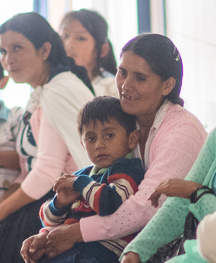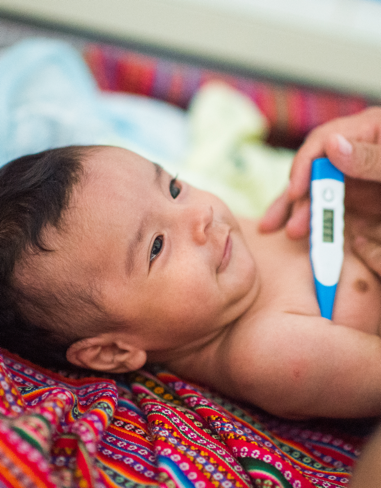Stunting reduction in Peru
Civil society and government collaborate to reach a tipping point
CONTENTS
Quick Downloads
KEY INSIGHTS
Peru’s government and civil society organizations collaborated to develop a deliberate, multi-sectoral strategy to reduce stunting that spanned across all levels of government. The evidence-based and targeted nature of interventions made them particularly effective.
Childhood stunting prevalence in Peru declined by 15 percent in eight years—from 28 percent in 2008 to 13 percent in 2016. Economic growth contributed to this decline but was not the primary driver. While stunting reduction was not uniform across the country, equity largely improved as stunting prevalence fell: rural areas (47 to 26 percent from 2008 to 2016) and lower wealth quintiles (54 to 30 percent for the poorest quintile) experienced some of the greatest improvements.
Health insurance for the poor
Since 2002, Peru has provided poor pregnant women and young children with free health insurance covering a broad spectrum of care.
To help establish a culture of health seeking, in 2002, Peru began to provide poor pregnant women and young children with free health insurance covering preventive, basic, maternal, and emergency care through the Seguro Integral de Salud (SIS). Initially, 35 percent of the poor received coverage for basic preventive care. Eventually, 70 percent of the poor were covered, with coverage rates reaching as high as 90 percent in poor and remote states such as Apurímac.
Health insurance coverage is credited with expanding health-seeking behavior and improving health generally in Peru, leading to reductions in stunting. Since 2002, mothers report their children have fewer respiratory infections and bouts of diarrhea. And when their children are sick, mothers report seeking medical care more often. Mothers are also more likely to seek care for themselves.

Conditional cash transfers
Nationwide program provides a bimonthly financial incentive for families that, among other things, comply with recommended MNCH interventions and enroll children in school.

To reduce poverty and connect young children and pregnant women with health services, Peru incentivized preventive health care and other social services.
In 2005, the country launched Juntos, a conditional cash transfer program which provides eligible households in the poorest 1,142 districts (of over 1,800 total districts) with 200 Soles ($63) every two months, if they follow an aggressive schedule of preventive growth monitoring, if their school-aged children enroll in school and maintain an attendance rate of at least 85 percent, if mothers attend health and hygiene counseling sessions, and if they obtain an identity card for their newborns.
As a result, Peru was able to double the number of visits to health services for children under five.
Improved maternal care
National programs to improve MNCH led to increases in health care utilization, and were associated with substantial reduction in childhood stunting.
To ensure women received the care and information they needed to raise healthy children, Peru improved the quality and availability of preventive health care for pregnant women. Peru’s Programa Salud Materno Neonatal (PSMN) was designed to reduce maternal and neonatal mortality by strengthening the health system’s ability to provide a basket of critical services for women and newborns and cultivating health seeking behavior by rural women.
As a result, the proportion of pregnant women who received four or more antenatal care visits increased from 69 percent in 2000 to 96 percent in 2016. Furthermore, improvements to women’s health and growth, related to reductions in fertility and increased spacing of pregnancies, were the largest factors affecting stunting in our decomposition analysis.

Improved preventive care for children
Frequent growth monitoring and preventive growth monitoring increased touch points between children and the health system.
To prevent growth faltering in young children, Peru improved the quality and frequency of preventive care for children.
Peru instituted an aggressive schedule of preventive growth monitoring for poor, rural children and expanded the national immunization schedule to include both the pneumococcal conjugate vaccine (PCV) and rotavirus vaccine. Growth monitoring and preventive growth monitoring for children, referred to a Control de Crecimiento y Desarollo (CRED) have included the following procedures: height and weight monitoring, Vitamin A supplements, deworming, and vaccinations.
The Programa Articulado Nutricional (PAN) drove a results-based financing approach, ensuring clinics in poor, rural communities were staffed and resourced to provide a standard regimen of quality preventive care.With this programming in place, the percentage of one-year-old children up to date on their immunizations more than tripled, from 25 percent in 2009 to 79 percent in 2016.

An extended health system
An increase in the number of health facilities and workers in rural areas extended access to health services to the most at-risk communities.
To expand its health care system to reach poor rural communities, Peru built clinics and equipped the facilities with adequate resources and staff. Between 1995 and 2000, Peru increased the number of public health facilities by 50 percent and increased the number of health workers by 10,000.
To reduce inequalities in access to quality health care between poor rural areas and relatively better off urban areas, Peru further increased the number of health workers placed in the poorest communities by 70 percent from 2007 to 2013. The Servicio Rural y Urbano Marginal en Salud (SERUMS), which supported staffing in the poorest areas, and the concomitant increase in access to health care, were significant drivers of Peru’s stunting reduction. Our regression analysis found that this programming had a large individual effect on stunting reduction.


Stunting reduction in Peru

Ask an Expert
Our team and partners are available to answer questions that clarify our research, insights, methodology, and conclusions.
